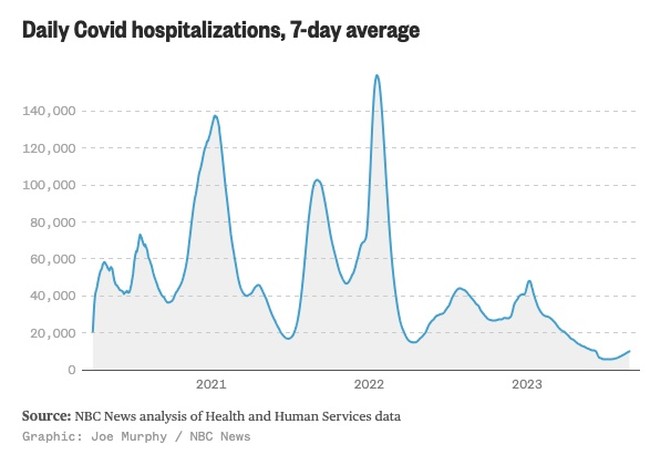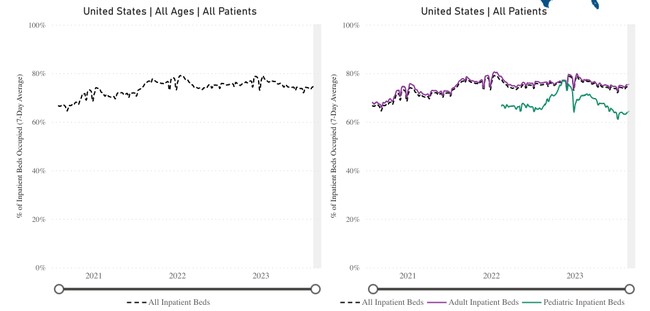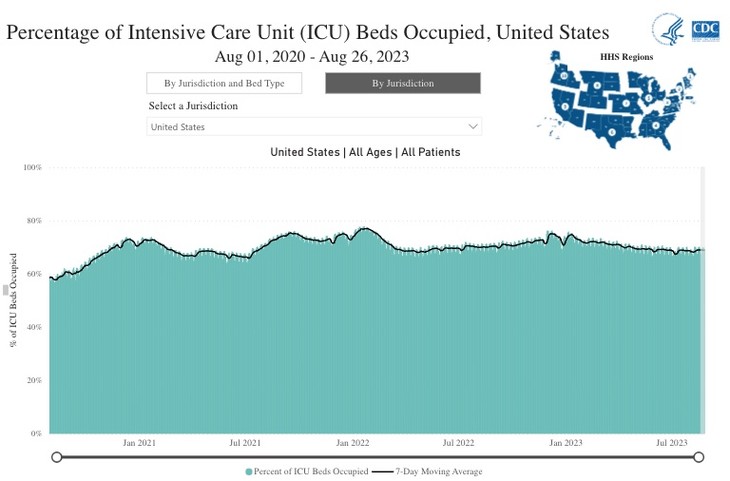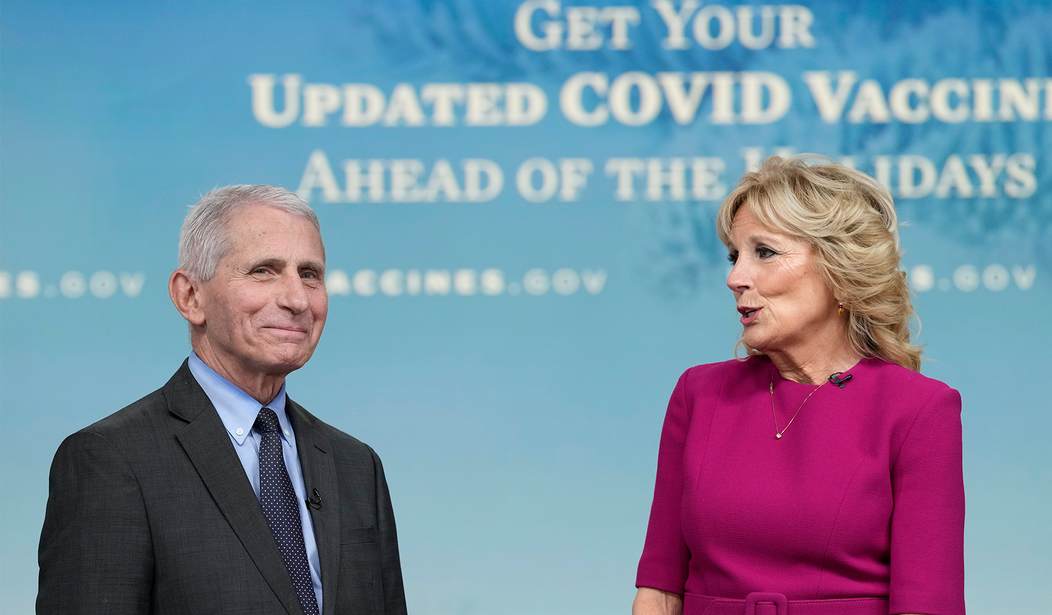Do they? They certainly do in the media, very much including this NBC News report. It has all the ingredients to sell a new season of COVID restrictions, too. New and improved variants! Wastewater! Hospitalizations and deaths “ticking up”! Hide the women and the young’uns, and break out the reinforced cloth masks with your favorite political slogan again!
Or maybe not, because as this particular report demonstrates, the media is still selling the same old panic with the same old bad data:
Hospitalizations are rising. Deaths have ticked up. Wastewater samples are picking up the virus, as are labs across the country.
“Every single one of those things is showing us that we have increased rates of Covid transmission in our communities,” said Jodie Guest, a professor of epidemiology at Emory University’s Rollins School of Public Health in Atlanta. …
Hospitalizations, for example, are “a very good indicator of severity of Covid disease,” Guest said.
No, they most certainly are not. And in fact, this correlative measure hasn’t functioned as even a somewhat relevant proxy for severity since the Delta variant.
Why? Because the CDC still counts hospitalizations and deaths as COVID related even when it plays no causative role in the event. The data is still entirely correlative; hospitals tested for COVID on all admissions, and any positive result was reported to the CDC as a COVID hospitalization, and while they’re no longer testing every admission, the data they do produce is still correlative, which we’ll get to momentarily. The same is true for reported deaths. Most other Western nations did and still do the same thing (Norway is among the exceptions), which makes them consistently useless in terms of public policy.
During the time that we tracked diagnoses for the original virus and the equally dangerous Delta variant, hospitalization did act as a somewhat relevant proxy, especially when other data was sparse or non-existent. When Omicron crowded out the earlier variants, however, it ended any relevance for correlative hospitalization and death statistics. Omicron and its successors followed the normal mutation track for novel viruses, becoming less lethal but more transmissible, and especially asymptomatically transmissible. Omicron spread rapidly through the US, quickly becoming dominant while producing much less danger in its uptake.
Did correlative hospitalizations spike upward with Omicron? Yes, they did — but the data didn’t indicate any increased severity of the pandemic. It was just the opposite: correlative hospitalizations spiked upward, but overall hospital utilization didn’t. Why? Because people weren’t going to the hospital because of COVID; they were going to the hospital for other reasons, only to discover they’d been exposed, which is exactly what one would expect in a population with a rapidly transmissible virus. Newer variants had much less risk for adverse outcomes, so much so that they are now akin to the flu or perhaps slightly less risky — which we would know if the CDC collected causative data rather than continue to work with correlative data.
This is so obvious, in fact, that Anthony Fauci himself had to admit it when an artificial spike in pediatric hospitalization reports initially led people to think that Omicron targeted children. It didn’t; the spread was so quick and widespread that it showed up everywhere, almost entirely asymptomatically. Shortly afterward, the CDC admitted to the issue and promised to fix it. That was in February 2022, and yet to this day the CDC continues to use correlative data that tells us nothing at all — but yet provides conveniently high numbers for current policymakers. Why is that? The question answers itself: the CDC benefits from COVID hysteria, both in terms of funding demands and in relation to the power it exercises over Americans in emergency situations.
NBC notes that while the CDC hasn’t changed its reporting requirements, hospitals have largely changed their testing regimes. They no longer test everyone, but only those who are “symptomatic,” which arguably means more direct measures. It doesn’t, of course, because the “symptomatic” threshold might be as mild as a runny nose or slight cough having nothing to do with the reason for the hospitalization. The test still has nothing to do with the reason the person was admitted to the hospital in the first place.
With that in mind, let’s get back to the recent data at NBC News, the one showing a spike in hospitalizations that their “expert” claims is a measure of severity. Here it is, straight from their own report:

Wow! Just look at the size of that spike! And be sure to use a magnifying glass when you do, because it’s barely recognizable. It’s well below the numbers of last winter’s levels, when we didn’t have an emergency on our hands. It looks like a seasonal virus variant has arrived and is working its way through the population, with no reports of any new or stronger adverse outcomes. Indeed, reading through the NBC report reveals no discussion at all of increased risks in this variant — not even a suggestion that this is any more dangerous than recent variants.
Now let’s take a look at the CDC’s data on overall hospital utilization over the exact same period, as of today:

Go to the CDC’s website to get a closer look if this came out a bit cramped. Even in this view, however, it’s clear that we aren’t seeing any significant uptick in hospital utilization. Even more interesting, we never saw the big spikes in utilization shown by the CDC’s COVID hospitalization data.
The latter doesn’t tell us a damned thing about “severity,” but speaks volumes about how bad data has been used to create unnecessary panic. As a bonus on this point, the CDC provides another helpful graph:

Post-Delta, hospital utilization has barely budged. Once facilities stopped postponing elective and non-emergent care to conserve resources, about a year after the pandemic started, utilization returned to normal levels and has remained steady ever since. And the same is true for ICUs as well, again from the CDC’s own data:

See the spike. Feel the spike. Be the spike!
The mainstream media wants to partner with government to sell panic and hysteria. That’s all this is, in every sense. A seasonal virus is coming around again and showing up in observational data, with absolutely no evidence that it’s any different than other seasonal viruses that do the same thing.
Andrew Malcolm and I discussed media narrative enforcement in our latest episode of The Ed Morrissey Show podcast too:
- Two years after the Taliban takeover, ISIS is now also resurgent — and insurgent in Afghanistan. Andrew and I discuss the failures of American policy and execution that led to these outcomes and the silence of the media.
- We also discuss a new essay at the Free Press that exposes the Academia-Media corruption around climate change.
- Plus, Andrew discusses his beautiful essay at Red State about his father and the quiet connection that keeps unexpectedly returning.
The Ed Morrissey Show is now a fully downloadable and streamable show at Spotify, Apple Podcasts, the TEMS Podcast YouTube channel, and on Rumble and our own in-house portal at the #TEMS page!








Join the conversation as a VIP Member